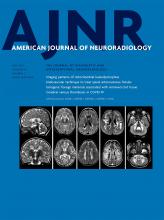Research ArticlePediatric Neuroimaging
Open Access
Quantitative Susceptibility Mapping of Venous Vessels in Neonates with Perinatal Asphyxia
A.M. Weber, Y. Zhang, C. Kames and A. Rauscher
American Journal of Neuroradiology July 2021, 42 (7) 1327-1333; DOI: https://doi.org/10.3174/ajnr.A7086
A.M. Weber
aFrom the Division of Neurology (A.M.W., A.R.)
bDepartment of Pediatrics and University of British Columbia MRI Research Centre (A.M.W., C.K., A.R.)
Y. Zhang
eDepartment of Radiology (Y.Z.), Children’s Hospital of Chongqing Medical University, Chongqing, China
fMinistry of Education Key Laboratory of Child Development and Disorders (Y.Z.), Chongqing, China
gKey Laboratory of Pediatrics in Chongqing (Y.Z.), Chongqing, China
hChongqing International Science and Technology Cooperation Center for Child Development and Disorders (Y.Z.), Chongqing, P.R. China
C. Kames
bDepartment of Pediatrics and University of British Columbia MRI Research Centre (A.M.W., C.K., A.R.)
cDepartment of Physics and Astronomy (C.K., A.R.)
A. Rauscher
aFrom the Division of Neurology (A.M.W., A.R.)
bDepartment of Pediatrics and University of British Columbia MRI Research Centre (A.M.W., C.K., A.R.)
cDepartment of Physics and Astronomy (C.K., A.R.)
dDepartment of Radiology (A.R.), University of British Columbia, Vancouver, British Columbia, Canada

References
- 1.↵
- Ferriero DM
- 2.↵
- Kurinczuk JJ,
- White-Koning M,
- Badawi N
- 3.↵
- Bryce J,
- Boschi-Pinto C,
- Shibuya K, et al
- 4.↵
- Barkovich AJ,
- Hajnal BL,
- Vigneron D, et al
- 5.↵
- Sarnat HB,
- Sarnat MS
- 6.↵
- Chalak LF,
- Rollins N,
- Morriss MC, et al
- 7.↵
- Logitharajah P,
- Rutherford MA,
- Cowan FM
- 8.↵
- 9.↵
- Salhab WA,
- Perlman JM
- 10.↵
- 11.↵
- 12.↵
- Thayyil S,
- Chandrasekaran M,
- Taylor A, et al
- 13.↵
- 14.↵
- 15.↵
- Pryds O,
- Greisen G,
- Lou H, et al
- 16.↵
- Lassen NA
- 17.↵
- Skov L,
- Pryds O,
- Greisen G, et al
- 18.↵
- 19.↵
- Shmueli K,
- de Zwart JA,
- van Gelderen P, et al
- 20.↵
- 21.↵
- Haacke EM,
- Xu Y,
- Cheng Y-CN, et al
- 22.↵
- 23.↵
- 24.↵
- 25.↵
- 26.↵
- 27.↵
- Antonucci R,
- Porcella A,
- Pilloni MD
- 28.↵
- 29.↵
- Sie LT,
- van der Knaap MS,
- Oosting J, et al
- 30.↵
- Barkovich AJ,
- Sargent SK
- 31.↵
- 32.↵
- 33.↵
- Li W,
- Wu B,
- Liu C
- 34.↵
- 35.↵
- Leenders KL,
- Perani D,
- Lammertsma AA, et al
- 36.↵
- 37.↵
- 38.↵
- 39.↵
- Ferrari M,
- Mottola L,
- Quaresima V
- 40.↵
- 41.↵
- 42.↵
- 43.↵
- 44.↵
- 45.↵
- 46.↵
- 47.↵
- 48.↵
- 49.↵
- 50.↵
- 51.↵
- Zhang Y,
- Rauscher A,
- Kames C, et al
- 52.↵
- 53.↵
- Tortora D,
- Severino M,
- Malova M, et al
- 54.↵
- Albayram MS,
- Smith G,
- Tufan F, et al
- 55.↵
- 56.↵
- Jopling J,
- Henry E,
- Wiedmeier SE, et al
- 57.
- van der Hoeven MA,
- Maertzdorf WJ,
- Blanco CE
- 58.
- Buchvald FF,
- Kesje K,
- Greisen G
- 59.
- 60.
In this issue
American Journal of Neuroradiology
Vol. 42, Issue 7
1 Jul 2021
Advertisement
A.M. Weber, Y. Zhang, C. Kames, A. Rauscher
Quantitative Susceptibility Mapping of Venous Vessels in Neonates with Perinatal Asphyxia
American Journal of Neuroradiology Jul 2021, 42 (7) 1327-1333; DOI: 10.3174/ajnr.A7086
0 Responses
Jump to section
Related Articles
Cited By...
- No citing articles found.
This article has not yet been cited by articles in journals that are participating in Crossref Cited-by Linking.
More in this TOC Section
Pediatric Neuroimaging
Similar Articles
Advertisement











